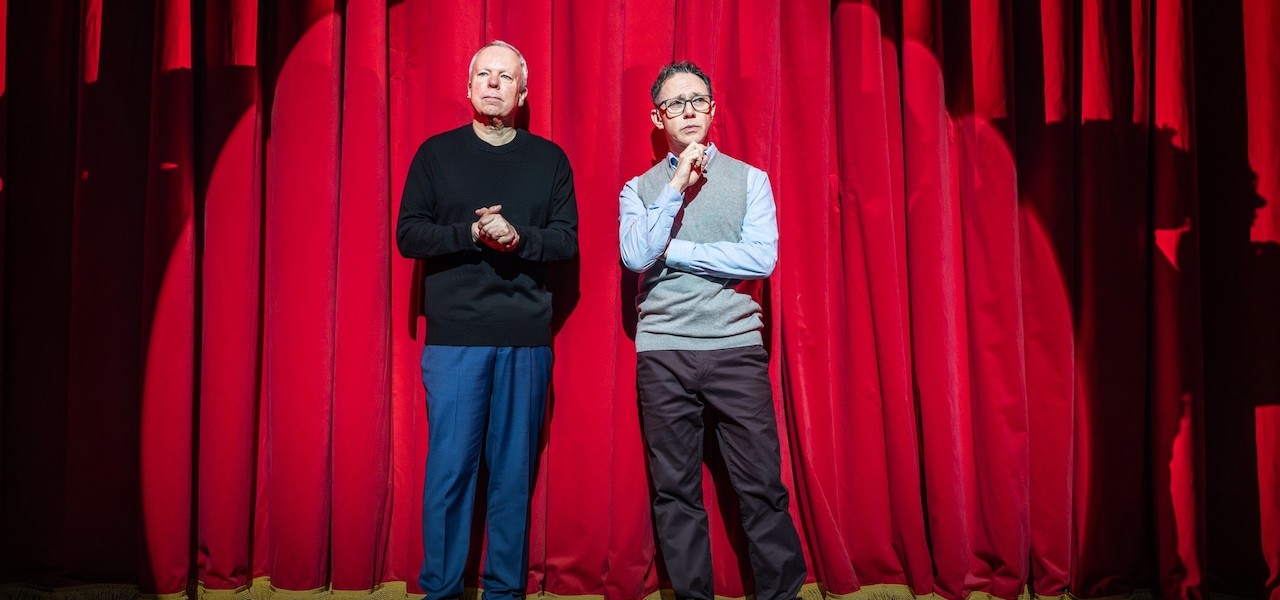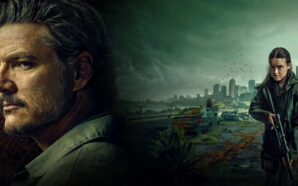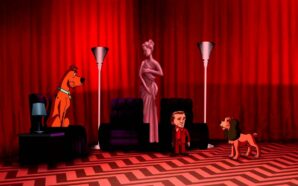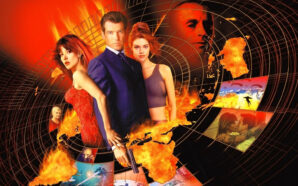Warning: Full Spoilers for Inside No. 9 Stage/Fright. This article was written in February 2025 but held back until the show had finished its run at Wyndham’s Theatre in an effort to prevent spoilers.
From when Inside No. 9 Stage/Fright was announced, to when I bought my tickets, to when I sat down to watch it, I didn’t know what to expect. What form would this West End production take? Would it be a play or more like the League of Gentlemen stage shows, composed of sketches? Inside No. 9, one of my favourite shows, is very much designed for television: an anthology of 30-minute episodes, each with a different story, tone, and style. How does that translate to the stage, and what connective tissue can a new narrative have with the show’s back catalogue of episodes? The answer is that Stage/Fright is kind of everything, and it’s fantastic.
The show begins with a great distillation of an Inside No. 9 story condensed into a short sketch, acting as an introduction to the show and it’s style, but also a message to the audience about theatre etiquette. Fans love picking apart the differences between Reece Shearsmith stories and Steve Pemberton stories and this is a very Reece story, fitting his sensibilities and personality perfectly. His character grows annoyed over inconsiderate theatregoers and begins killing them off one-by-one. It’s the perfect opening, offering a taste of the comedic yet dark tone, the effects (blood spray from one of the murders), and plays with the medium of a stage show, with the audience watching another audience watch another play in a meta twist, which the rest of Stage/Fright will further embrace.
Then begins the framing device of the show, the overarching narrative linking all the sketches and stories. Reece and Steve tell the tale of Bloody Belle, the ghost that supposedly haunts the Wyndham theatre. It’s a new story constructed for Stage/Fright, or at least I think it is. They do a great job weaving it into the old ghost stories of the West End, written about in the programme, with it truly feeling like a classic story you’d hear rumours of, creating a sense of verisimilitude. It also makes the show specific to the Wyndham, one of several reasons why Stage/Fright fits a residency and will be difficult to tour. The location is vital to the storytelling.
Much of the first act is Reece and Steve performing Bernie Clifton’s Dressing Room. It’s the one big reprisal of the television series and the perfect choice for this stage show. It’s a beloved episode, a two-hander, a celebration of old school entertainment, and won them the comedy award, so it’s not hard to see why it was picked. But it’s not just a repeat; this version brings some new recontextualised aspects. There’s absolutely new purpose in revisiting it here. Firstly, it’s an episode about performing on stage so feels more at home on an actual stage with an audience than on TV.
But also within the narrative of the show, with the final twist at the end, choosing Bernie Clifton’s Dressing Room adds another layer. The story is about Reece’s character having an imagined conversation with his dead friend, the twist at the end of the episode being that Steve’s character has been dead the whole time, but Stage/Fright will reveal that Reece himself actually died and his understudy Toby has been apparently playing his role(s) the entire time. Therefore this sketch brings new significance, with Steve being the one to act with his dead friend. The pick of this episode is a fun clue to what is really happening.
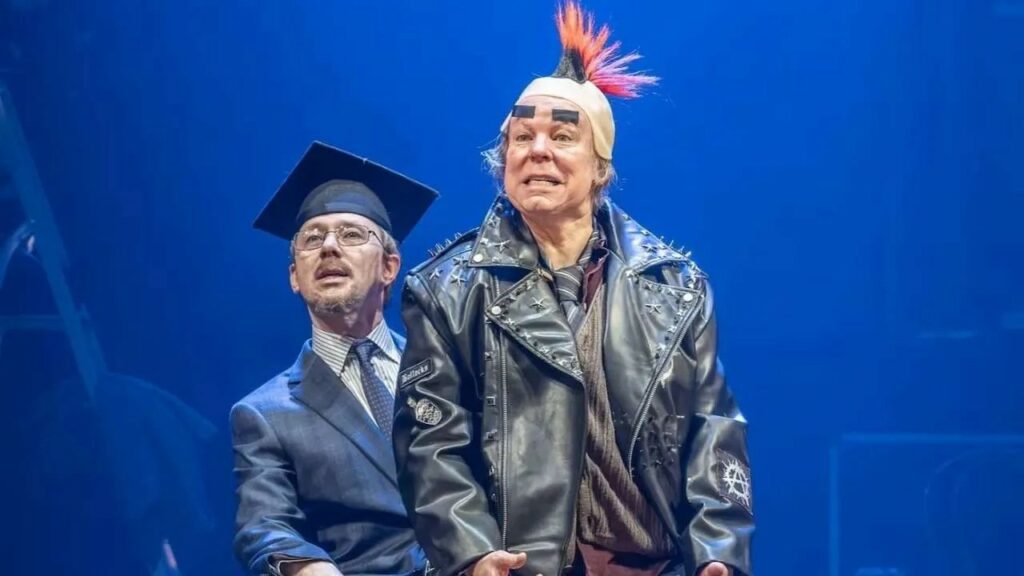
Breaking up the extended Bernie Clifton section (before it is interrupted by Bloody Belle, giving it a new ending), we get a kidnapping sketch featuring the two burglar characters from A Quiet Night In. But because they can speak, unlike the silent episode, it’s revealed Steve is essentially playing Barry Baggs, and Reece a Lisgoe-esque character, bringing an element of The League of Gentlemen into the show. Stage/Fright might be the culmination of Inside No. 9 but there are also links to previous projects. The sketch also includes a great callback to Sardines, a hare on the stair, and in the performance I saw Steve hilariously made Reece break character and laugh with an impassioned cry of “it was only a stick of celery!”
Each performance of Stage/Fright sees a new celebrity guest star kidnapped. I saw the Saturday 8th February matinee show so the special guest was Denis Lawson, making it truly A Quiet Night In reunion, which is one of my favourite episodes. The kidnapped celebrity is forced to say and do ridiculous things in what I assume is a semi-improvised situation, such as having to pretend to be a Spanish man from Newcastle who Flamenco dances. And because this is Inside No. 9, they are then promptly shot and thrown down some stairs. This is one of the aspects that made me want to see the show a second time (but alas, it’s impossible because the limited run is sold out) to see how the tasks change and different people react.
As with the first, the second act begins with a loud bang and cut to black that’s impossible not to jump to, yet the content of the second half is different to the first. Instead of sketches, it’s one narrative, albeit one which evolves and reveals new layers. It begins as a broadly comedic horror story, which is then revealed to be a play within a play, a revival of the play in which the actress Bloody Belle died, the origin of the ghost story. Is the ghost haunting the new production, as she has seemingly been Stage/Fright itself, or is it all a ploy for the director to scare off the actress he never wanted to cast? It’s meta, with the cast playing multiple versions of themselves.
The opening of the second half was probably my favourite part of the show. I love the influence old horror movies have had over Reece and Steve’s career, films like Theatre of Blood, and this was a fun embrace of those stories. A big melodramatic over-played gory horror story, part Grand Guignol, part Garth Marenghi’s Darkplace when it’s revealed they’re all actors. There’s the sawing off of legs and the drilling of heads, it’s great fun, and the actors, particularly Anna Francolini and Miranda Hennessy shine in this section. Then each added layer, the reveal that it is a play within a play based on another play, was great, and there were some meta jabs at West End productions. I can only assume that the celebrity casting was a joke about Steve working with Lily Allen on a play – I gather she won’t be one of the celebrity guests during the kidnapping section.
One of the smaller twists in this section really got me. One of the ushers interrupts the performance to bring the actors some coffee, revealing that the horror story we’ve been watching is just a play within a play. But then the usher remains onstage and starts performing and it turns out she’s another actress in the production, Gaby French, who previously appeared in the episode Love’s Great Adventure. To sell the twist, she was acting as an actual usher for the first half, showing us to our seats.
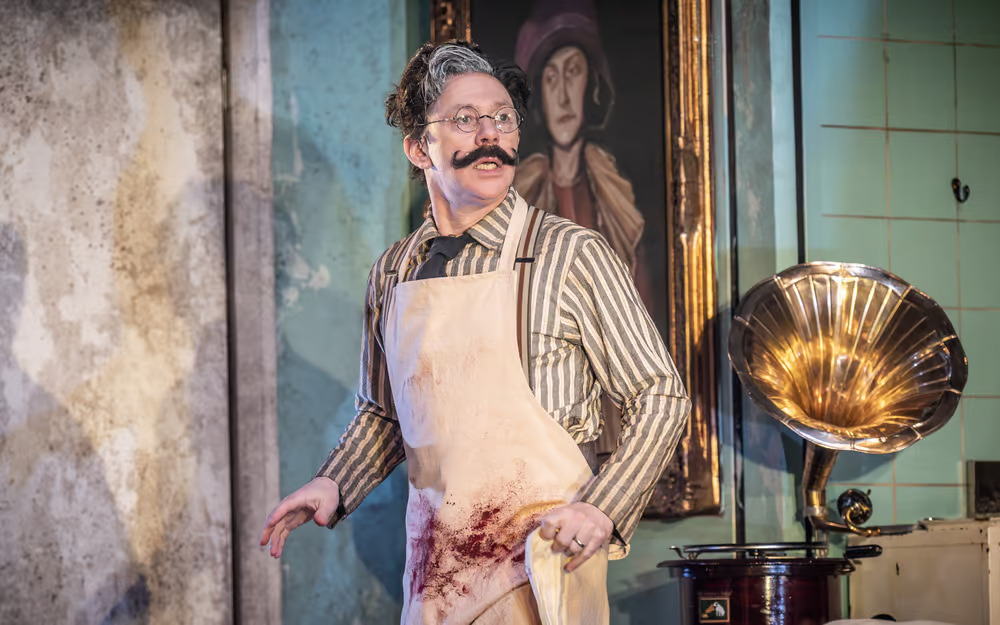
After a few scares throughout, this is where the play goes full horror, juxtaposed against the broad comedy of the second act’s beginning. It’s very well done and effective. Steve makes some gags about how all productions now have cameras following people, the live footage projected onto a screen, and then the show itself does just that. Night vision is used as the camera travels around the stage looking for the ghost, pointing out into the audience, and I felt for sure it would appear next to me considering I was at the end of row D, next to the corridor. Then the camera travels backstage and underneath it, similar to live episode Dead Line, expanding the scope of the story beyond the stage. At one point, the camera even starts moving on its own. I wonder if any of it was pre-recorded, and if so then the transitions are seamless. It’s also another reason why touring is tough, and even recording the show would be difficult. The production is so well designed as a stage stow in that specific location.
As much as Reece and Steve, but mainly Reece, moan about Inside No. 9 being known as ‘the show with the twist at the end’, of course there’s a twist at the end of Stage/Fright. It’s effective and could have been silly if it wasn’t executed so well. Reece’s character is killed by the ghost, the apparent end of the show, and the cast appear to bow and receive a deserved standing ovation. But when Reece pops up from the stage, it’s not him. Steve makes a speech and Reece has apparently been dead the whole time, Stage/Fright put on in his honour, with his understudy Toby having played his roles all night. Obviously, that’s just part of the narrative, but it did make me question when was Reece Reece and when was Toby Reece?
I saw Reece fall to the floor, I’m sure I did, but when he rose up it wasn’t him. Did they swap when a distraction happened, a classic case of misdirection, or was it always Toby but with looped dialogue from Reece? I have no idea. I would love to see it again to try and work it out. I guess that’s why the show has an illusionist credited. Earlier in the show, Reece flubbed a line, saying “Rubik’s clube” instead of cube and it felt like a natural mistake. Steve uses it to point out that Toby still isn’t perfect in his performance. Was this flub planned or a honest mistake cleverly weaved into the narrative?
With Reece revealed dead, we then see the shadow of his ghost behind the curtain and he drops a light on Steve, killing him, although he was aiming for Toby. The show ends with the “If you’re going to cry…” song from Bernie Clifton’s Dressing Room performed in heaven, the two writers and stars of Inside No. 9 dead but performing together, a perfect Inside No. 9 light and dark ending. It feels similar to the original farewell to Tubbs and Edward in The League of Gentlemen Are Behind You, going to heaven after dying in the TV show (before resurrecting for the anniversary specials).
Crafting an ending to the television show Inside No. 9 was a tough task. I liked the finale of the series, Plodding On. It was a celebration, a farewell, a revival of different aspects, and a spotlight on Reece and Steve’s relationship. But it almost felt like a half measure. It didn’t quite go far enough. Stage/Fright is the true finale of Inside No. 9 in a lot of ways. It does what Plodding on did but better and more. It weaves in past episodes and characters, tells a new story, is scary and funny and dramatic, and offers a finale for Reece and Steve, the thread throughout Inside No. 9. Them dying, not just faking their deaths in their office, is the perfect dark yet sweet ending. I’ve often heard the two of them say that their best stuff is on stage and that’s true here. They managed to make something designed perfectly for TV, an anthology, and give it the perfect conclusion in a theatre, with Stage/Fright ending up as one of their greatest achievements.




